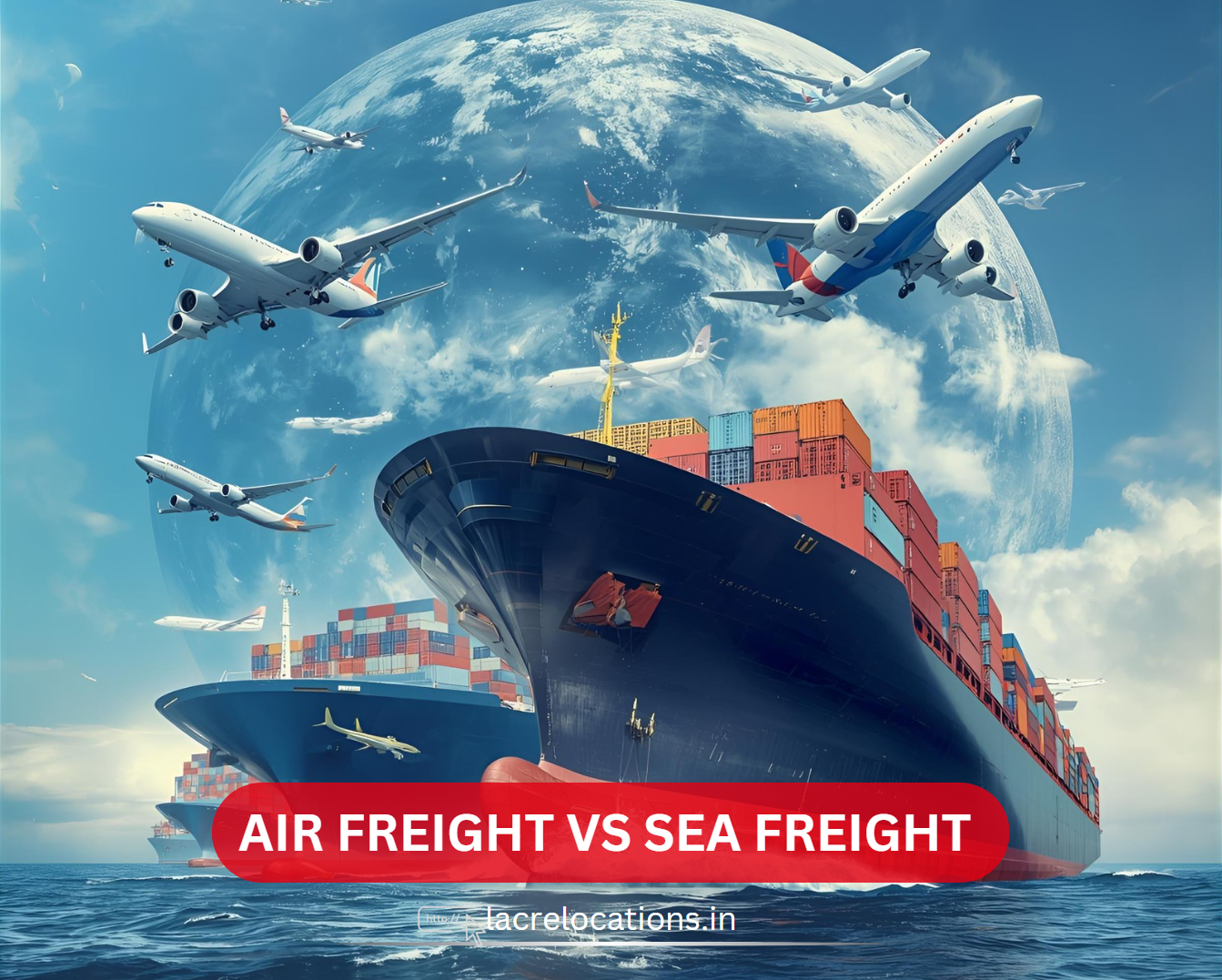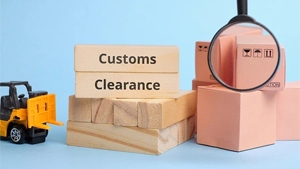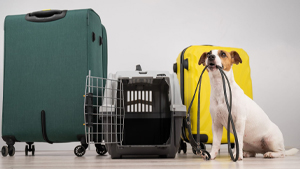One of the most important decisions business has to make is to decide how to move its goods around the world. If you get it wrong, you face delays, angry customers, and lose money. The international shipping options you choose have an impact on how quickly your packages arrive, how much they cost, how happy your customers are and the overall health of your supply chain. In 2025, global shipping trends show more pressure than ever. Customers expect fast, reliable delivery. Businesses seek cost control and efficiency. This makes the Air Freight vs Sea Freight debate crucial. Both methods have major upsides and downsides. Knowing the difference is key to smarter global logistics solutions and finding the best freight forwarding services. We’ll break down both options to help you choose the right mode for your business needs.
Why You Need to Compare Air and Sea Freight
Every shipment has a unique set of needs. It can be urgent, fragile or massive. This guides the kind of shipment you choose. Smart businesses don’t just pick the affordable or fastest option. They choose the one that fits the product, the timeline, and the budget. The decision affects everything from your inventory levels to your cash flow. Comparing these two modes is vital for surviving and thriving in international trade.
Emerging trends in global shipping for 2025
Trends in 2025 show a shift toward better visibility in shipping. Businesses want real-time tracking for every item.Sustainability is also becoming a bigger factor. Companies are looking at the environmental cost of their transport choices. This means the carbon footprint of Air Freight vs Sea Freight is a new part of the decision. Finally, port and airport capacity are strained globally. This makes scheduling and reliability more complex than ever.
What is Air Freight?
Air freight services involve moving goods using air carriers. This means putting cargo onto specialized freighter planes or in the belly of commercial passenger jets. The process is fast and precise. Your freight forwarding services partner manages the shipment from your location to the airport. The main steps include booking space, preparing documentation, screening the cargo, and loading it quickly. It is the gold standard for fast shipping solutions.
Types of air freight
- Standard Air Freight: This is the most common and cost-effective air option. It uses scheduled flights and takes a few days.
- Express Air Freight: This is the fastest, often using dedicated courier networks. It’s for very urgent, small shipments.
- Air Charter: You rent an entire plane. This is for huge, unique, or extremely urgent loads where no scheduled flight can work.
Advantages of Air Freight
Air freight is all about speed and reliability.
- Ultra-fast transit: Delivery can take just 1–3 days port-to-port. It’s ideal for urgent shipments.
- Reliability: Flight schedules are usually fixed and followed closely, leading to minimal delays compared to ocean shipping.
- Security: Cargo spends less time moving and is handled more securely in airports. This means a reduced risk of damage or theft.
Ideal Cargo for Air Freight
Air cargo shipping is best for products including high-value items like electronics, high-fashion goods and perishable goods shipping such as fresh flowers, foods, or medical supplies that spoil quickly.
Limitations of Air Freight
The speed comes at a price.
- High cost: It is significantly more expensive than sea freight.
- Limited cargo capacity: Planes can only carry so much weight and volume. It’s not great for massive, heavy goods.
- Higher carbon footprint: Per pound of cargo, air freight uses much more fuel and creates more emissions than ocean freight.
How to calculate air freight cost (weight vs volume)
Air freight cost is based on the chargeable weight. This is the heavier number between the actual gross weight and the volumetric weight (or dimensional weight). The volumetric weight calculation takes the cubic size of the package and converts it to a theoretical weight. The formula is usually: Length x Width x Height (in cm) / 6000. You pay for the space you take up or the actual weight, whichever is greater.
Air freight insurance and risk management tips
Since air shipments are often high-value, proper insurance is crucial. You want a policy that covers the full value of the goods. Risk management for air freight services means ensuring perfect documentation to prevent customs delays. It also involves using strong, light-weight packaging to protect the items without adding too much to the chargeable weight.
Choosing the right air freight provider
Look for an air freight provider with a strong global network. They should have a good track record for on-time delivery. They also need excellent relations with major airlines. Check their ability to handle customs clearance in your destination country. A good provider is key to getting the most out of air cargo shipping.
What is Sea Freight?
Sea freight services move goods inside containers on massive ships. It is the backbone of global trade, moving the vast majority of the world’s products. The process starts with packing goods into a standard shipping container which moves by truck or train to a large port. It is then loaded onto a container ship, sails the ocean, and arrives at the destination port. After customs clearance, it is moved to its final delivery point.
Types of sea freight
- FCL (Full Container Load): You pay for and use the entire container, even if you don’t fill it. This is usually the affordable way to ship when you have enough cargo.
- LCL (Less than Container Load): Your goods share space in a container with other companies’ goods. You only pay for the space you use. This is better for smaller shipments.
- Ro-Ro (Roll-on/Roll-off): Specialized ships used for vehicles and rolling cargo. Cars and trucks are driven onto the ship.
Advantages of Sea Freight
Ocean shipping offers massive scale and savings. It is the best option for bulk cargo shipping.
- Cost-effective for bulk shipments: The cost per unit or per ton is very low. This makes it the most cost-effective shipping method for large orders.
- High capacity: Ships can carry hundreds or thousands of containers. They can easily handle heavy and oversized cargo, such as large machinery.
- Eco-friendly per ton-mile: While ships cause pollution, they are far more fuel-efficient per ton of cargo moved than planes.
Ideal Cargo for Sea Freight
Ocean freight shipping is perfect for raw materials, machinery, furniture, toys, and other non-urgent bulk goods. If the product is not time-sensitive and is heavy or large, sea freight is the smart choice.
Limitations of Sea Freight
The main drawback is speed.
- Slower transit (15–45 days): The journey itself is long. Expect anywhere from two weeks to over a month.
- Port delays: Congestion at major ports can cause long waits before a ship is loaded or unloaded.
- Weather-dependent: Bad weather at sea or in port can cause delays.
Choosing between FCL and LCL
The choice depends on volume. If your cargo is more than 13 cubic meters (about half a 20-foot container), FCL is usually cheaper and faster. FCL also means your cargo is sealed and generally safer from handling damage. If your shipment is small, LCL is your only option. However, LCL means extra time for consolidation (packing the container) and deconsolidation (unpacking it).
Sea freight documentation and customs requirements
Sea freight services involve complex documents. You will need a Bill of Lading (the contract of carriage), a commercial invoice, and a packing list. Customs clearance is detailed and can be slow. Accurate paperwork is essential to avoid fines or delays at the port.
Sea freight insurance and risk mitigation strategies
Insurance for ocean freight shipping is essential due to the high risk of loss or damage on a long journey. Strategies to reduce risk include choosing reputable shipping lines. Also, use strong, waterproof packing materials. Consider shipping during less busy times of the year to avoid peak port congestion.
Transit Time Explained: Air Freight vs Sea Freight Delivery Speed
The choice between Air Freight vs Sea Freight is most starkly defined by delivery speed. Understanding the difference in shipping speed comparison is vital for effective logistics planning. Generally, air freight delivery time is measured in days, while sea freight transit time is measured in weeks. Air freight typically offers transit from airport-to-airport in just 1 to 7 days, making it the only choice for urgent shipments, high-value electronics, or highly perishable goods. In contrast, sea freight requires a much longer timeframe, averaging 15 to 45 days or more from port-to-port, especially for transcontinental routes. This difference is driven by numerous factors beyond the distance. For air freight, delays are usually limited to customs processing, severe weather, or short-term flight issues. For sea freight, the process is far more susceptible to long, unpredictable delays caused by port congestion, where ships can wait days or even weeks to unload, as well as unpredictable routing changes and major weather events at sea. Therefore, while air freight guarantees speed and reliability, sea freight requires extensive planning and a larger buffer in your delivery estimates.
How to estimate delivery dates for international shipments
To estimate delivery, use a formula that includes more than just transit time. Add 1–3 days for origin-side handling (pickup, packaging). Add the main transit time (1–7 days for air; 15–45 days for sea). Then, add 2–7 days for destination-side handling (customs, unloading, final delivery). Always build in a small buffer for unexpected delays.
Seasonal factors affecting transit times
Shipping volumes spike during certain times. Sea freight gets very busy during major holidays like Christmas. This is the peak season for moving retail inventory. Shipments slow down right after the Lunar New Year holiday in Asia. Air freight also sees rate and volume spikes before major holidays. Plan ahead for these times.
Express air freight vs standard sea freight: pros and cons
- Express Air Freight:
Pros: Nearly guaranteed next-day or 2-day delivery.
Cons: Extremely high cost, only suitable for small packages.
- Standard Sea Freight:
Pros: Very low cost for large volume.
Cons: Long and highly variable transit time. The low cost benefit of sea freight is often worth the drawback of its slow speed if you manage inventory well.
Cost Comparison: Air Freight vs Sea Freight – What’s More Affordable in 2025?
Cost is often the main decider in the Air Freight vs Sea Freight choice. Air freight is priced at a premium. Sea freight offers huge savings for volume. Knowing the latest air freight rates 2025 and sea freight cost 2025 is essential. Air freight is calculated by the chargeable weight and priced per kilogram
- Cost per/kg: This is the main rate. It changes based on fuel costs and demand.
- Fuel surcharges: A variable fee to cover the cost of jet fuel.
- Handling fees: Charges for moving the cargo at the origin and destination airports.
Sea freight costs
Sea freight is priced differently, mainly by container or by ton.
- Cost per container/ton: FCL is a flat fee for the box. LCL is based on the volume or weight your goods take up.
- Port charges: Fees collected by the ports for loading, unloading, and using the port facilities.
- Customs fees: Duties, taxes, and service fees for clearance.
Hidden costs in the freight cost comparison
Don’t forget the costs that are not part of the main freight bill:
- Insurance: Protecting your shipment.
- Storage (Demurrage/Detention): Fines for leaving containers too long at the port (sea freight) or terminal (air freight). These can be very expensive.
- Last-mile delivery: The cost to move the goods from the airport or port to your final warehouse or customer.
Scenarios when air freight is cost-effective
Air freight can actually be an affordable shipping option in some limited scenarios.
- High-value, low-volume goods: If a delay in a shipment causes you to miss a sale, the cost of air freight is worth the guaranteed speed.
- Perishable goods: If the product goes bad in 10 days, sea freight is not an option, making air freight the only cost-effective choice.
- To avoid high warehousing costs: If your warehouse is full, paying higher air freight to deliver just in time can be affordable than paying for extra storage space.
Sea freight is always better for bulk cargo because the massive volume drives the unit cost down to pennies.
Door-to-door vs port-to-port cost comparison
- Port-to-Port/Airport-to-Airport: This is the affordable quote you will get. It only covers the travel time. You handle all logistics on both ends.
- Door-to-Door: This is the most convenient and often the final cost you should plan for. It includes pickup, all transit, customs clearance, and final delivery to your warehouse. Always request a door-to-door quote for true cost comparison.
Cost-saving tips for both shipping modes
For air freight, try to lighten your packaging and ship during off-peak times. For sea freight, consolidate as much cargo as possible to use FCL. Use a good freight forwarding services partner.
How freight forwarders help reduce shipping costs
A freight forwarder acts as your shipping agent. They handle all paperwork. More importantly, they have relationships with multiple carriers and can negotiate better rates. They can also combine your LCL shipment with others to fill a container, saving you money. They are essential for finding the most affordable shipping options.
The Pros and Cons of Air Freight and Sea Freight
This side-by-side comparison makes the differences clear. The right choice depends entirely on which column of pros matters most to your product and business.
Comparison Chart for Easy Understanding
| Factor | Air Freight | Sea Freight |
| Ideal Cargo | High-value, perishable, urgent, small. | Low-value, non-urgent, heavy, bulk. |
| Transit Time | 1–7 days | 15–45+ days |
| Cost | High (per / kG) | Low (per container/ton) |
| Capacity | Low | High |
| Reliability | High | Medium to Low |
Environmental impact comparison (carbon footprint)
The carbon footprint is a growing concern. On a per-ton-mile basis, sea freight is significantly more energy-efficient than air freight. If your business is focused on sustainability, choosing ocean shipping for non-urgent goods is a much greener decision. New low-sulfur fuels and ship designs are making sea freight even cleaner.
Risk factors: theft, damage, delays
- Theft and Damage: Air freight is generally more secure due to less handling and shorter transit. Sea freight, especially LCL, involves more moving and sorting, increasing the risk of damage.
- Delays: Sea freight is far more prone to long, unpredictable delays due to port issues or weather. Air freight delays are usually shorter and due to weather or mechanical issues.
Insurance and liability differences
The liability limit of the carrier is often different between air and sea. Air carrier liability is usually higher per /kg. But for high-value goods, you should always buy all-risk marine or air cargo insurance. Relying only on the carrier’s limited liability is risky.
Air Freight vs Sea Freight: What Works Best for E-commerce Businesses?
For e-commerce, speed and customer satisfaction are closely linked. Customers expect a tracking number within a few days. This makes the choice between air and sea complex.
- Air freight for electronics, fashion, urgent shipments: If you are selling expensive jewelry, the newest smartphone or fast-changing seasonal fashion, air freight is essential.
- Sea freight for bulk inventory, seasonal goods: You should use sea freight for large batches of low-cost items, like toys for Christmas or bulk t-shirts. You need to plan many months ahead to account for the long transit time.
- Hybrid approach for peak seasons: Many e-commerce businesses use a blend. They ship the majority of their stock by cheap ocean freight shipping. Then, they use costly air freight to quickly restock best-selling items that sell out faster than expected. This balances cost with availability. This is a crucial element of smart e-commerce shipping solutions.
Case examples of successful e-commerce logistics strategies
A major toy seller ships 90% of its inventory via sea freight services in June and July. This keeps its total shipping costs low. But in October, when a specific action figure sells out early, they use air vs sea freight for e-commerce by placing a small, urgent air order to cover the six weeks until the next sea container arrives.
Inventory management tips using both air and sea freight
Keep your high-selling, small-volume items flowing with a mix of air and sea. Use sea freight to build a base level of inventory. Use air freight for fast refills when sales peak. This stops you from running out of stock, which is the biggest cost in e-commerce.
How to reduce shipping costs while maintaining delivery speed
To keep costs down, focus on packaging size to reduce volumetric weight for air freight. For sea freight, work with your supplier to fill containers perfectly. Use a fulfillment center near your final market to cut down on expensive, international last-mile air shipping.
Key Factors to Consider When Choosing Between Air and Sea Freight
The ultimate decision needs to be based on facts, not just habit. Use these factors to guide your choice of shipping mode selection.
- Cargo type: Is it perishable or fragile (needs air)? Is it heavy or bulky (needs sea)?
- Delivery urgency: Do you need it this week (air)? Or in a month (sea)?
- Budget constraints: Can the profit margin support the high cost of air freight?
- Environmental sustainability: Does your company or customer require a lower-carbon option?
- Customs and regulatory requirements: Some dangerous goods cannot fly, forcing a sea route.
These factors form the basis of a strong freight shipping decision factors framework.
Total landed cost calculation
You must calculate the Total Landed Cost. This is the full cost of the product when it arrives at your door. It includes the cost of the goods, the main freight charge, insurance, customs duties, and local delivery. You might find that the higher air freight cost is offset by not having to pay for 30 days of inventory storage.
Checklist for choosing the right shipping method
- What is the deadline for this order?
- What is the volume and weight?
- What is the item’s dollar value?
- How much is our profit margin per unit?
- What is the risk of delay to our business?
Answer these five questions for every shipment to choose the right mode.
Tips for working with freight forwarders
Treat your freight forwarder like a partner. Share your business goals and inventory plans. A good forwarder will advise you to use Air Freight vs Sea Freight not just on cost, but on what is best for your supply chain health. They are your best source for optimized logistics solutions.
Case Studies: Air Freight vs Sea Freight in Action
These freight case studies show how different products require different strategies.
Electronics shipped via air freight: speed and reliability benefits
A company launching a new smartphone used air freight for the first few weeks of sales. While expensive, it ensured the product hit stores globally at the same time. The speed created buzz and stopped competitors from gaining an early edge. The high reliability of air freight meant they avoided costly launch delays.
Machinery shipped via sea freight: cost efficiency for bulk
A manufacturer of large industrial washing machines ships a dozen 5-ton units from Asia to Europe. The total shipment weighed over 60 tons. Shipping this by air was financially impossible. Using FCL sea freight was the only choice. The lower cost offset the 40-day delivery time, making the project profitable. This shows the advantage of air vs sea freight examples for heavy goods.
Hybrid approach for seasonal e-commerce stock: balancing cost and delivery speed
A clothing brand needed 5,000 summer dresses from Vietnam. They shipped 4,500 by ocean freight shipping in a 40-foot container. When the dresses started selling faster than expected, they sent the remaining 500 units via express air freight to prevent an out-of-stock situation during their peak sales window. This clever blend maximized savings and minimized lost sales.
ROI analysis: air vs sea
The Return on Investment (ROI) is not just about the shipping bill. It’s about the total profit. The air shipment had a higher shipping cost, but the ROI was higher because it allowed the company to keep selling high-profit items. The sea shipment had a lower shipping cost, making the total ROI positive for the bulky, lower-margin items.
Lessons learned from each case study
The key lesson is that urgency dictates air; volume dictates sea. Never use the default option. Always review the item and its sales velocity before you book.
Decision-making strategies based on product type and urgency
If the product is perishable, time-sensitive, or high-value, choose air. If the product is bulky, low-value, or not time-sensitive, choose sea.
Conclusion: Air Freight vs Sea Freight – Choosing the Right Mode for International Shipping
The choice between Air Freight vs Sea Freight decision is a central one in global logistics solutions.
The key differences are clear:
- Speed: Air takes 1–7 days. The sea takes 15–45+ days.
- Cost: Air is expensive per/ KG. The sea is cheap per container.
- Capacity: Air has limited capacity for goods. The sea can ship massive goods.
- Cargo: Air for perishable/high-value. Sea for bulk/heavy.
- Environment: Air has a higher carbon footprint.
For most businesses, the best shipping mode for business is a thoughtful blend of the two. Use sea freight for your core, stable inventory. Use air freight as a strategic tool for emergencies, new product launches or fast-selling items.
Do not make this complex choice alone. Consult with experienced freight forwarding services experts. They can provide a fresh look at your supply chain and offer tailored logistics consultation to optimize your shipping strategy for cost and speed. Regularly evaluating your shipping needs ensures you remain efficient and profitable in the changing global market.

















